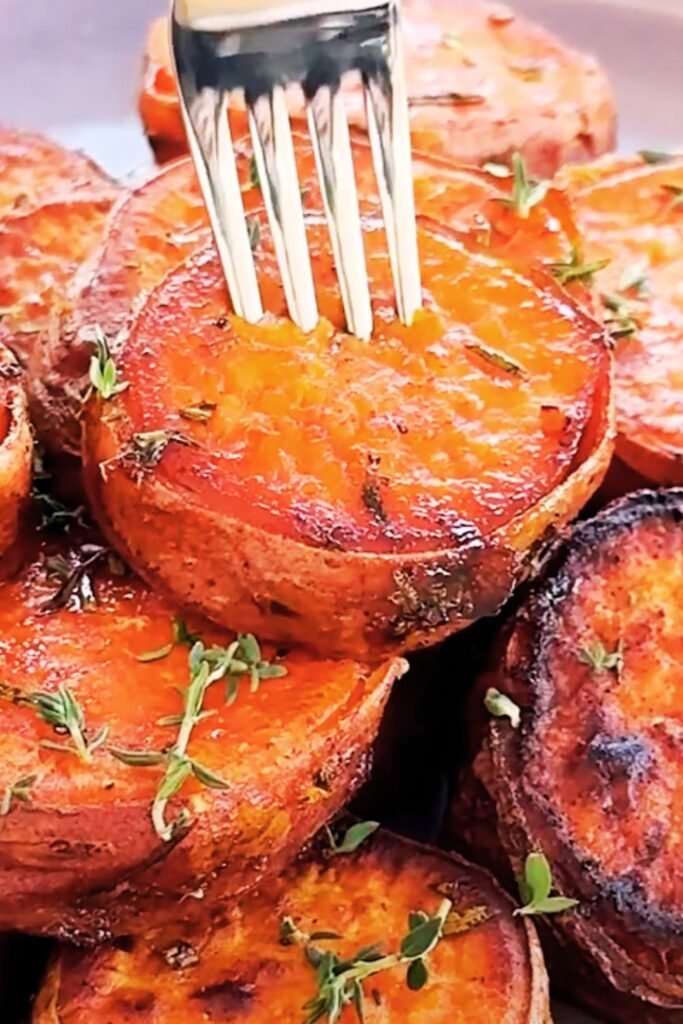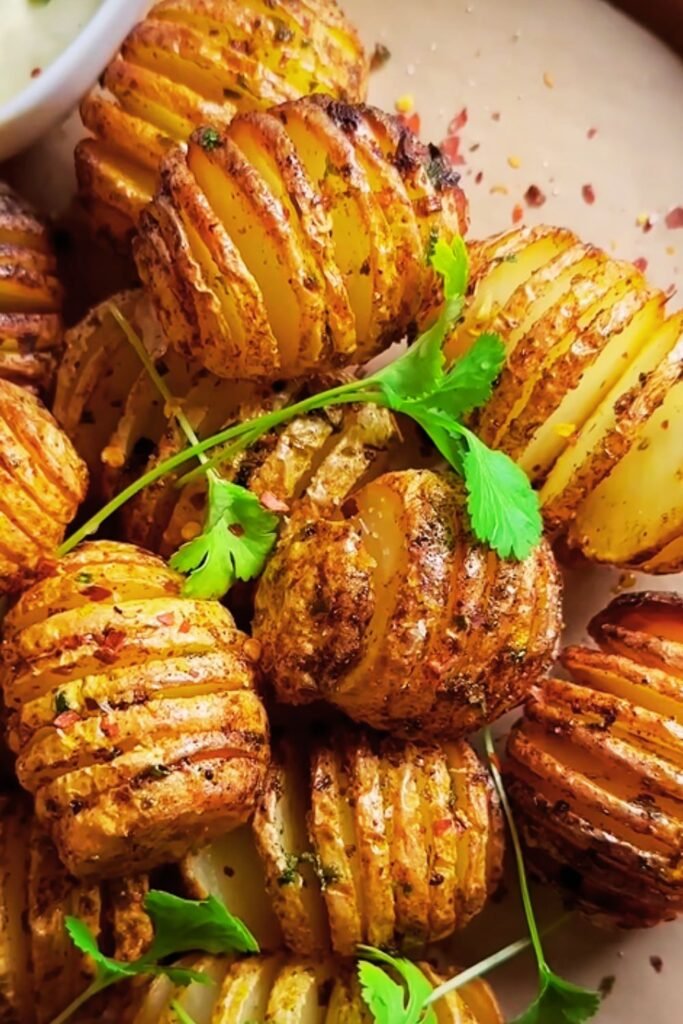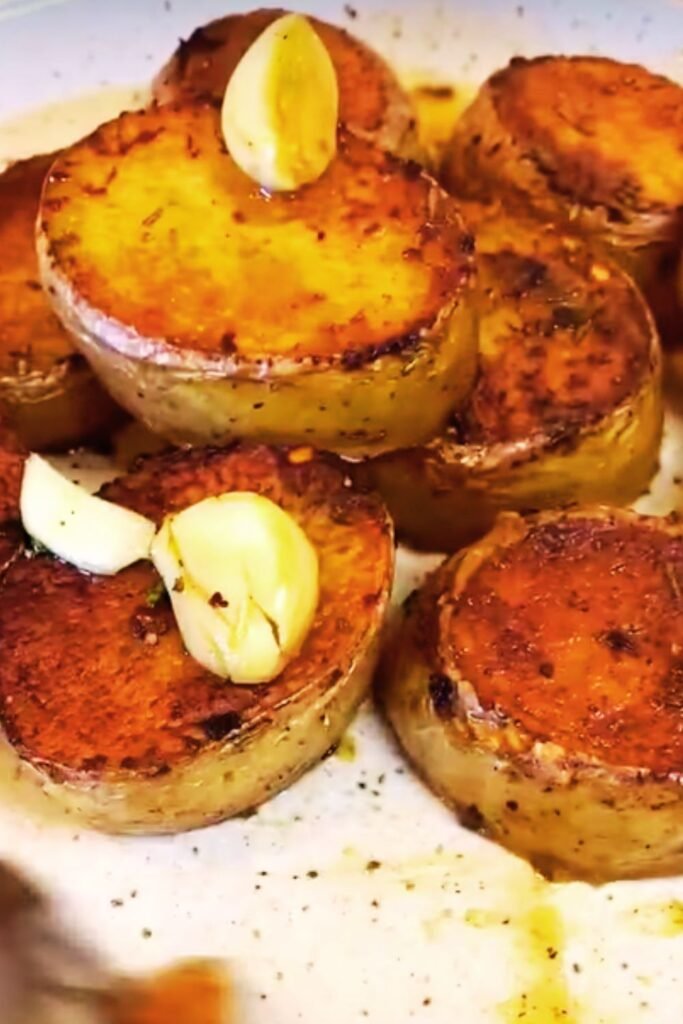I’ve been making melting potatoes for over a decade, and let me tell you—this dish never fails to impress. When I first discovered this French technique, I was amazed at how something so simple could deliver such extraordinary results. The contrast between the golden, crispy exterior and the impossibly fluffy interior creates a potato experience that’s nothing short of magical.
Melting potatoes, or “pommes fondantes” as they’re known in French cuisine, represent the perfect marriage of technique and simplicity. Unlike roasted potatoes that can sometimes turn out dry, or boiled potatoes that lack character, melting potatoes achieve that sweet spot where every bite delivers both texture and flavor. The addition of fresh herbs elevates this classic dish to restaurant-quality status, making it perfect for both weeknight dinners and special occasions.
Understanding the Melting Potato Technique
The beauty of melting potatoes lies in the cooking method itself. This isn’t just another roasted potato recipe—it’s a carefully orchestrated process that combines searing, braising, and roasting to create something truly special.
Key Cooking Principles:
- High-heat searing creates the initial crust
- Gentle braising ensures even cooking throughout
- Oven finishing develops the perfect texture
- Proper seasoning at each stage builds layers of flavor
The science behind melting potatoes is fascinating. When I sear the potatoes at high heat, I’m creating what’s called the Maillard reaction—the same process that gives bread its crust and steak its sear. This reaction not only creates incredible flavor but also forms a protective barrier that keeps the interior moist while the outside becomes beautifully crispy.
Selecting the Perfect Potatoes
Not all potatoes are created equal when it comes to melting potatoes. Through years of experimentation, I’ve learned that potato selection can make or break this dish.
Best Potato Varieties:
| Variety | Starch Content | Texture Result | Best For |
|---|---|---|---|
| Yukon Gold | Medium | Creamy, holds shape | Traditional melting potatoes |
| Russet | High | Fluffy interior, crispy exterior | Maximum contrast |
| Red Potatoes | Low | Firm, waxy texture | Herb-forward versions |
| Fingerling | Medium-Low | Unique shapes, even cooking | Elegant presentations |
I personally prefer Yukon Gold potatoes for melting potatoes because they strike the perfect balance between starch and moisture. Their naturally buttery flavor complements the herbs beautifully, and they hold their shape well during the cooking process.
Size Considerations:
- Medium potatoes (2-3 inches diameter) work best
- Uniform sizing ensures even cooking
- Avoid potatoes with eyes or green spots
- Choose potatoes with smooth, unblemished skin
Essential Fresh Herbs for Melting Potatoes
The herb selection can dramatically transform your melting potatoes from good to extraordinary. I’ve experimented with countless combinations, and here are my favorites:

Primary Herb Combinations:
| Herb Blend | Flavor Profile | Best Season | Cooking Stage |
|---|---|---|---|
| Rosemary + Thyme | Earthy, pine-like | Fall/Winter | During searing |
| Sage + Parsley | Bright, slightly peppery | Spring/Summer | Final garnish |
| Oregano + Basil | Mediterranean, aromatic | Summer | Mixed throughout |
| Chives + Dill | Fresh, onion-like | Spring | Final garnish |
Herb Preparation Tips:
- Always use fresh herbs when possible
- Strip woody herbs like rosemary and thyme from stems
- Chop delicate herbs like parsley and chives just before serving
- Reserve some herbs for garnish to maintain bright color
My go-to combination is fresh rosemary and thyme during cooking, finished with chopped fresh parsley. The rosemary and thyme infuse the potatoes with deep, earthy flavors during the cooking process, while the parsley adds a bright, fresh note that lightens the dish.
The Complete Melting Potatoes Recipe
Ingredients:
- 2 pounds Yukon Gold potatoes, peeled and cut into 2-inch thick rounds
- 3 tablespoons olive oil
- 2 tablespoons butter
- 2 sprigs fresh rosemary
- 3 sprigs fresh thyme
- 4 garlic cloves, smashed
- 1 cup chicken or vegetable broth
- 2 tablespoons fresh parsley, chopped
- Salt and freshly ground black pepper to taste
Equipment Needed:
- Large oven-safe skillet (cast iron preferred)
- Sharp knife
- Cutting board
- Measuring cups and spoons
- Oven mitts
Step-by-Step Instructions:
Preparation Phase:
- Preheat your oven to 425°F (220°C)
- Wash and peel potatoes, then cut into 2-inch thick rounds
- Pat potatoes completely dry with paper towels
- Season both sides generously with salt and pepper
- Let potatoes sit for 10 minutes to draw out moisture
Searing Phase:
- Heat olive oil in a large oven-safe skillet over medium-high heat
- When oil shimmers, carefully add potato rounds in a single layer
- Don’t move them for 4-5 minutes until golden brown
- Flip and sear the other side for another 4-5 minutes
- Add butter, rosemary, thyme, and garlic to the pan
Braising Phase:
- Carefully pour broth around (not over) the potatoes
- The liquid should come about halfway up the potato sides
- Transfer the entire skillet to the preheated oven
- Cook for 25-30 minutes until potatoes are tender when pierced
Finishing Phase:
- Remove from oven and let rest for 5 minutes
- Garnish with fresh chopped parsley
- Serve immediately while hot

Troubleshooting Common Issues
Even experienced cooks sometimes encounter challenges with melting potatoes. Here are the most common problems I’ve encountered and how to solve them:
Problem: Potatoes Fall Apart
- Solution: Choose waxy or medium-starch potatoes
- Avoid over-handling during cooking
- Ensure potatoes are completely dry before searing
Problem: Exterior Won’t Crisp
- Solution: Pat potatoes completely dry before cooking
- Use higher heat for initial searing
- Don’t overcrowd the pan
Problem: Interior Remains Hard
- Solution: Cut potatoes to uniform thickness
- Ensure adequate braising liquid
- Extend oven cooking time if needed
Problem: Burnt Bottom
- Solution: Reduce initial searing heat
- Use heavy-bottomed pan for even heat distribution
- Monitor closely during oven phase
Nutritional Benefits and Information
Melting potatoes with fresh herbs offer more than just incredible taste—they’re also packed with nutrients:
Nutritional Breakdown (per serving):
| Nutrient | Amount | % Daily Value | Health Benefit |
|---|---|---|---|
| Vitamin C | 45mg | 75% | Immune system support |
| Potassium | 620mg | 18% | Heart health, blood pressure |
| Fiber | 3.2g | 13% | Digestive health |
| Vitamin B6 | 0.3mg | 15% | Brain function |
| Antioxidants | Various | N/A | Anti-inflammatory properties |
The fresh herbs add their own nutritional benefits. Rosemary contains compounds that may improve memory and concentration, while thyme provides antimicrobial properties. Parsley is rich in vitamin K and folate, making this dish both delicious and nutritious.
Creative Variations and Serving Suggestions
After mastering the basic technique, I love experimenting with different variations:
Seasonal Variations:
- Spring: Add fresh peas and mint in the last 5 minutes
- Summer: Include cherry tomatoes and basil
- Fall: Incorporate roasted garlic and sage
- Winter: Add caramelized onions and thyme
Protein Pairings:
- Roasted chicken or turkey
- Grilled salmon or white fish
- Beef tenderloin or lamb chops
- Vegetarian option: Serve with roasted vegetables
Sauce Accompaniments:
- Herb butter melted over hot potatoes
- Garlic aioli on the side
- Lemon herb vinaigrette
- Chimichurri for a South American twist

Advanced Techniques for Restaurant-Quality Results
To take your melting potatoes to the next level, consider these professional techniques I’ve learned over the years:
The Double-Sear Method: Instead of flipping once, sear each side twice for extra crispiness. This creates multiple layers of the Maillard reaction, resulting in deeper flavor and better texture.
Herb Oil Infusion: Create an herb oil by gently heating olive oil with hardy herbs like rosemary and thyme. Strain and use this flavored oil for searing—it adds incredible depth.
Compound Butter Finish: Mix softened butter with chopped fresh herbs, garlic, and lemon zest. Add a dollop to each potato just before serving for restaurant-quality richness.
Storage and Reheating Guidelines
While melting potatoes are best served immediately, sometimes you need to prepare them ahead:
Storage Tips:
- Refrigerate cooked potatoes for up to 3 days
- Store in airtight container
- Keep herbs separate to maintain color and flavor
- Don’t freeze—texture will suffer
Reheating Methods:
- Oven: 350°F for 10-15 minutes
- Skillet: Medium heat with a little oil
- Avoid microwave—destroys crispy texture
Wine and Beverage Pairings
The rich, herbaceous flavors of melting potatoes pair beautifully with various beverages:
Non-Alcoholic Options:
- Sparkling water with lemon
- Fresh herb-infused iced tea
- Apple cider with rosemary
- Ginger ale with fresh thyme
Hot Beverages:
- Herbal teas complement the dish beautifully
- Rich coffee balances the potato’s earthiness
- Hot chocolate for a cozy winter meal
Seasonal Menu Planning
I love incorporating melting potatoes into seasonal menus:
Spring Menu:
- Melting potatoes with fresh peas and mint
- Grilled asparagus
- Herb-crusted salmon
- Fresh strawberry salad
Summer Menu:
- Melting potatoes with basil and tomatoes
- Grilled zucchini and bell peppers
- Herb-marinated chicken
- Mixed green salad with vinaigrette
Fall Menu:
- Traditional melting potatoes with rosemary
- Roasted Brussels sprouts
- Braised short ribs
- Apple and walnut salad
Winter Menu:
- Melting potatoes with sage and garlic
- Roasted root vegetables
- Slow-cooked beef stew
- Warm kale salad
Q&A Section
Q: Can I make melting potatoes ahead of time? A: While they’re best served fresh, you can partially prepare them by completing the searing phase earlier in the day. Store in the refrigerator and finish in the oven when ready to serve. The texture won’t be quite as perfect, but they’ll still be delicious.
Q: What’s the difference between melting potatoes and roasted potatoes? A: The key difference is the cooking method. Melting potatoes use a combination of searing and braising, which creates a unique texture—crispy outside, incredibly fluffy inside. Roasted potatoes are typically cooked entirely in the oven and don’t achieve the same contrast.
Q: Can I use dried herbs instead of fresh? A: While fresh herbs are preferred, you can use dried herbs in a pinch. Use about one-third the amount called for and add them during the searing phase. The flavor won’t be as bright, but it will still be tasty.
Q: Why do my potatoes stick to the pan? A: This usually happens when the pan isn’t hot enough or the potatoes aren’t dry enough. Make sure your pan is properly preheated and the potatoes are completely patted dry. Also, don’t move them too soon—let them develop a proper crust before flipping.
Q: Can I make this recipe vegan? A: Absolutely! Replace the butter with additional olive oil and use vegetable broth instead of chicken broth. The flavor will be slightly different but still delicious.
Q: How do I know when the potatoes are done? A: The potatoes should be golden brown on both sides and easily pierced with a fork. If you’re unsure, insert a knife into the center—it should slide in with little resistance.
Q: Can I add other vegetables to the pan? A: Yes! Root vegetables like carrots, parsnips, or turnips work well. Add them at the same time as the potatoes, but cut them to similar sizes for even cooking.
Q: What if I don’t have an oven-safe skillet? A: You can transfer the seared potatoes to a baking dish, add the herbs and broth, and finish in the oven. The results will be similar, though you might lose some of the concentrated flavors from the pan.
Q: How can I make smaller portions? A: This recipe scales down easily. Use a smaller skillet and adjust the cooking times slightly. For two servings, use about 1 pound of potatoes and halve the other ingredients.
Q: Can I freeze cooked melting potatoes? A: I don’t recommend freezing cooked melting potatoes as the texture will suffer significantly. The high moisture content causes ice crystals to form, which breaks down the fluffy interior texture that makes these potatoes special.
This recipe has become one of my absolute favorites to serve at dinner parties because it looks elegant but is surprisingly simple to execute. The combination of crispy exterior, fluffy interior, and fresh herb flavors creates a memorable side dish that complements almost any main course. Whether you’re cooking for family or entertaining guests, melting potatoes with fresh herbs will surely become a staple in your culinary repertoire.